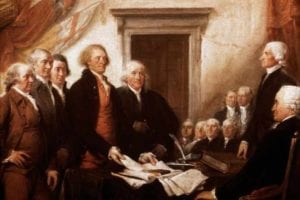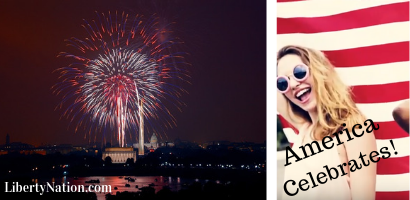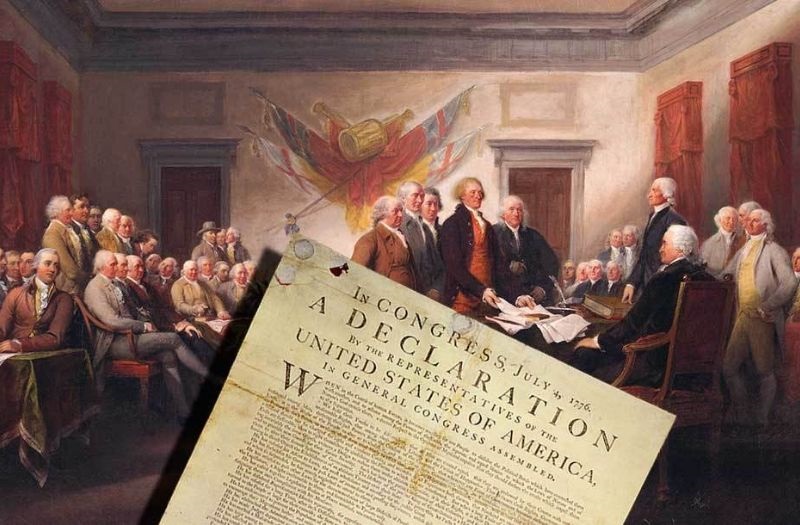At a time when Americans are torn between patriotism and identity crisis, now more than ever we must look back on the importance of the Fourth of July, the day America gained its independence from Britain. Have we lost the meaning of this national holiday? Are we too busy being worried about not offending transgender, or taking offense over a Nike shoe design that depicts the Betsy Ross flag? Is finding objection to everyone and everything that we don’t agree with more important than honoring our nation, increasing our patriotism, and trying to make America great again? Just how different were we as a new country in 1776 compared to now?
The Original Independence Day: July 4, 1776
 Some may argue that the actual date to celebrate America’s independence should be July 2, when the motion to separate from Great Britain was first approved. However, the Declaration of Independence was first printed on July 4, 1776, and that was the date listed on the document, so Fourth of July became the official day of celebration.
Some may argue that the actual date to celebrate America’s independence should be July 2, when the motion to separate from Great Britain was first approved. However, the Declaration of Independence was first printed on July 4, 1776, and that was the date listed on the document, so Fourth of July became the official day of celebration.
We already know the history of how our independence was won, so let’s take a look back at how our ancestors celebrated this victory.
John Adams was one who didn’t agree on the celebration being on the fourth instead of the second and most of the time turned down any invitations to celebratory events unless they were on July 2. He had been so excited about the declaration that the day after it was approved, he wrote his wife Abigail saying that their “Day of Deliverance ought to be solemnized with Pomp and Parade, with Shews, Games, Sports, Guns, Bells, Bonfires and Illuminations from one End of this Continent to the other from this Time forward forever more.”
The 1776 celebration wasn’t yet what Adam’s had envisioned. In the Bowling Green section of Manhattan, military personnel and civilians tore down a statue of King George III, melting it into bullets. In Philadelphia, the king’s coat of arms was used as kindling for a bonfire. Citizens burned the king in effigy and held a mock funeral for his royalness in Savannah, Georgia.
 The next year, however, the celebrations resembled much more of what we’re familiar with today. Ships lining the harbor were decorated with patriotic colors. Fireworks lit up the sky, including platforms with “fizzing” fireworks that morphed into patriotic images such as of George Washington. Gunfire, cannon blasts, and artillery salutes echoed throughout the land.
The next year, however, the celebrations resembled much more of what we’re familiar with today. Ships lining the harbor were decorated with patriotic colors. Fireworks lit up the sky, including platforms with “fizzing” fireworks that morphed into patriotic images such as of George Washington. Gunfire, cannon blasts, and artillery salutes echoed throughout the land.
On June 14, 1777, the Continental Congress passed a resolution to create and accept the new nation’s first flag. “Resolved, that the Flag of the thirteen United States shall be thirteen stripes, alternate red and white; that the Union be thirteen stars, white on a blue field, representing a new constellation.” Since this was just a couple of weeks before the independence celebration, it is likely the first flag made its appearance that evening.
The Virginia Gazette described the first July 4 celebration in Philadelphia, claiming it a success:
“The evening was closed with the ringing of bells, and at night there was a grand exhibition of fireworks, which began and concluded with thirteen rockets on the commons, and the city was beautifully illuminated. Every thing was conducted with the greatest order and decorum, and the face of joy and gladness was universal.”
Independence Day in the 21st Century
Yes, we still celebrate with fireworks, gorging ourselves at family barbecues, live bands and dancing, parades, and all the traditional things we associate with this holiday. But is the meaning still there? Are we celebrating because we are patriotic or because it’s a day away from our jobs? According to a recent Gallup Poll, it may be more the latter for most:
- 45% are “extremely” proud, the second straight year of sub-50% readings.
- 22% of Democrats are extremely proud, down ten points in one year.
- Americans are most proud of U.S. scientific success and the military, but least proud of politics.
Most of us could probably agree that current political agendas are the main source of contention among Americans. The biased media has a heavy role in the dissention, and their antics have not lessened for this holiday. MSNBC, for example, has said it will not air the president’s “Salute to America” event planned for July 4. Donald Trump’s celebration was expected to be more of a show of military might than just fireworks and speeches. The show is to include planes, tanks, military bands, and drill teams. And wouldn’t you know it, there are planned rallies from the ever-so-tolerant left to protest the event.
Colin Kaepernick is at it again, showing everyone just how unpatriotic he is by calling out Nike and saying he was offended by the company’s new shoe that featured a depiction of Betsy Ross’ flag design. And Nike, true to its nature, caved under the ex-professional football player’s demands and canceled the shoe, saying the company had “concerns that it could unintentionally offend and detract from the nation’s patriotic holiday.”
is at it again, showing everyone just how unpatriotic he is by calling out Nike and saying he was offended by the company’s new shoe that featured a depiction of Betsy Ross’ flag design. And Nike, true to its nature, caved under the ex-professional football player’s demands and canceled the shoe, saying the company had “concerns that it could unintentionally offend and detract from the nation’s patriotic holiday.”
In April, students at a Long Island, NY university demanded the removal of Founding Father Thomas Jefferson’s statue, saying the figure was offensive and racist – the same man who wrote the Declaration of Independence, setting the grounds for the freedom we enjoy today.
Patriotism is losing its meaning at a time when we should all be pulling together to make our country strong. We should be uniting, not dividing, but too many are obsessed with opposing all those with views differing from their own. The division between the aisles is absolute and obvious; however, one truth remains clear: Republicans tend to be more patriotic and proud of their country. According to the Gallup Poll:
“The latest overall declines in patriotism are largely driven by Democrats, whose self-reported pride has historically been lower and has fluctuated more than Republicans’. Democrats’ latest 22% extreme pride reading is the group’s lowest in Gallup’s 19 years of measurement, and is half of what it was several months before Donald Trump’s 2016 election victory.
“For their part, most Republicans have remained extremely proud of their country, and the latest 76% reading is just 10 points below the high recorded in 2003. Even when Barack Obama was in office, Republicans’ extreme pride never fell below 68%.
“Independents have historically been less proud of the U.S. than Republicans have been; currently, 41% express extreme pride — which is, by one point, the lowest reading in the trend.”
~
At Liberty Nation, we love to hear from our readers. Comment and join the conversation!




